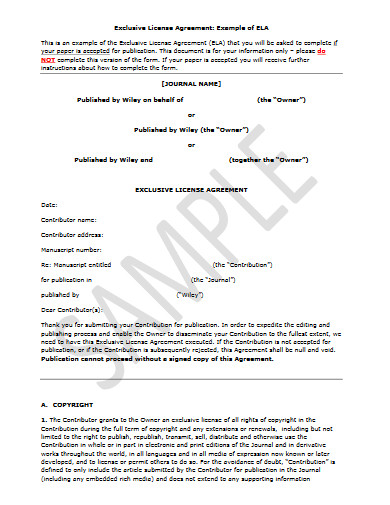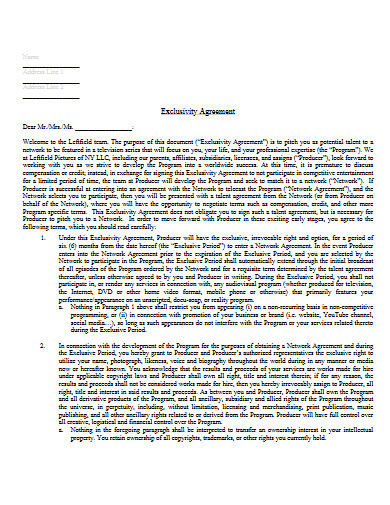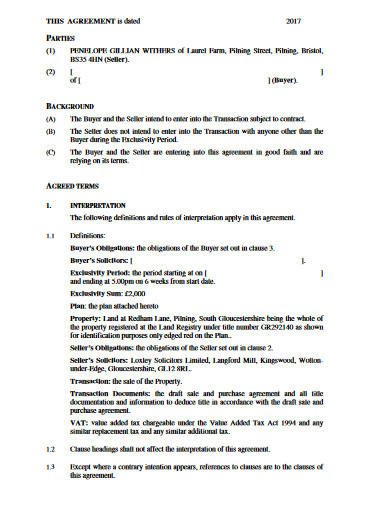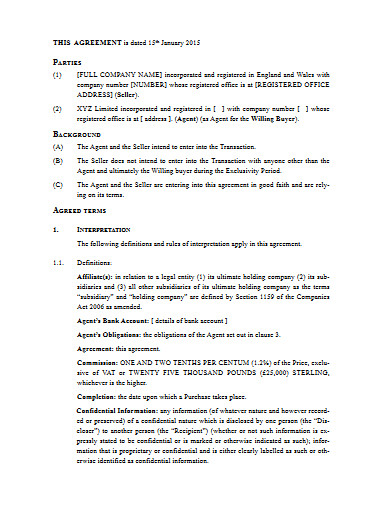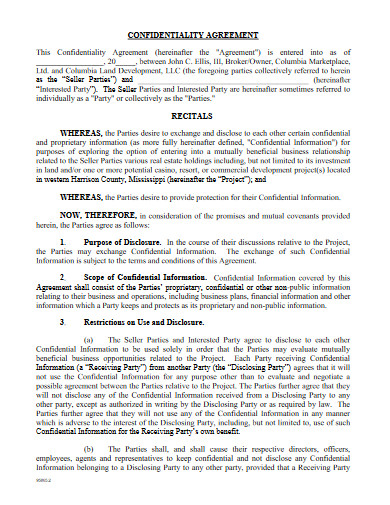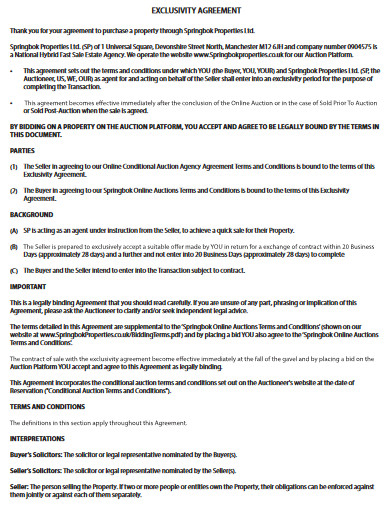10+ Exclusivity Agreement Examples to Download
Becoming a sole distributor, vendor, or service provider is unarguably advantageous for a company. With all the purchase orders going straight to your company, you no longer have to worry about competitors. But for your company to do so, you have to get into an exclusivity agreement, then into a contract with various firms in a certain territory. Sometimes, private companies also look to have partnerships with these manufacturing, consulting, and other types of businesses, to get significant benefits, such as discounts on their supply of products or services. We can help you draft the said agreement! All you have to do is take a peek on our library of examples and skim through our highly relevant article below!
10+ Exclusivity Agreement Examples
1. Restaurant Exclusivity Agreement Template
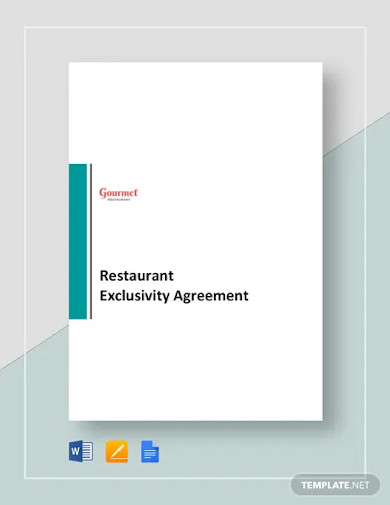
2. Exclusivity, Confidentiality and Assignment of Work Product Template
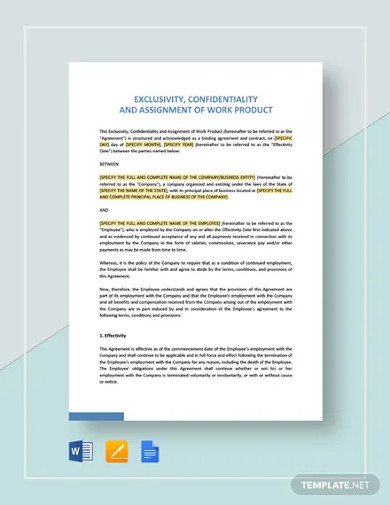
3. Exclusive Buyer Service Agreement
4. Broker Exclusivity Agreement
5. Exclusive License Agreement
6. Exclusive Seller Representation Agreement
7. Exclusivity Agreement Example
8. Land Exclusivity Agreement
9. Exclusivity or Option Agreement
10. Confidentiality and Exclusivity Agreement
11. Buyer Exclusivity Agreement
What is an Exclusivity Agreement?
An exclusivity agreement is a legal document that binds two organizations in a business arrangement where one party offers to sell to the other exclusively. At the same time, the purchasing party ensures to avoid purchasing the proposed type of goods to other parties. In the sellers’ viewpoints, the process document can help them establish a competitive advantage through the specified restriction. Through the document, the company also revamps the distribution of their goods and services. However, the exclusivity agreement also has drawbacks. To give you one, the participants are limited from grabbing more favorable deals from other parties. Failure to respect the limitation could result in legal consequences.
Business Transactions With Exclusivity Feature
Exclusivity is a privilege for both buyers and sellers. This feature is common in all business transactions that consist of the following classifications:
1. Supply Agreement – This transaction describes the manufacturing and supplying of goods of one party to the other.
2. Distribution Agreement – In this undertaking, manufacturers make deals with distributors to sell their goods to the market.
3. Business Negotiation – As the name implies, businesses who are under a business negotiation cannot negotiate with other parties during the process.
4. Commercial Lease Agreement – A company under such an agreement can include the exclusivity feature to enable it to sell a certain product in its location exclusively.
How To Create an Exclusivity Agreement
Agreements must adopt technical writing to ensure the balance between technicality and simplicity. Part of the said practice is making sure that each component of the document corresponds with the standards. Just by knowing that, we know that you’re already thinking about how daunting the task of making an exclusivity agreement is. This is why we have our outline of guidelines below to help you make your process document thorough and well-written.
1. Name the Involved Parties
Whether it’s a managed services agreement, guardianship agreement, or any agreement, you should always start by providing the basic information of the involved parties, such as the complete legal names and their respective addresses. After giving out their names, indicate who the seller is and who the buyer is.
2. State the Purpose
After giving off the basic information of the agreement’s participants, proceed with the statement of the purpose. It should give off the complete definition of the agreement, including the short-term and long-term goals that the aforementioned participants longed to achieve. These details must be in the same section with the latter step.
3. Present Terms and Conditions
Once you have stated the purpose of your document, present your terms and conditions. This section must consist of different subsections that highlight the important matters that must be taken into account. These subsections should include the list of goods and the manufacturer’s suggested retail price (MSRP), delivery notes, payment methods, payment schedules, and taxes. Besides those, you have to incorporate the statement of a warrant and specifications of the inspection plan and its corresponding report.
4. Set the Termination Clause
Agreements, like your exclusivity agreement, have risks. To protect you from any loss when these risks present themselves, you have to set a termination clause. These risks have two categories – defaults and force majeure. Defaults include the nonpayment, insolvency of either the party, appropriation by their party’s creditor, and delayed obligation delivery. On the other hand, force majeure consists of vandalism, military actions, acts of God, weather interruptions, acts of terrorism, and earthquakes.
5. Confidentiality
Every business document contains sensitive pieces of information. Because of this, you have to make a clause whose intention is to protect the said information from any form of infringement. In this section, the parties have to agree to keep all the details of the agreement confidential, and that any request for access by a third party has to go through the main involved parties.
6. Non-Disparagement and Notices
Conclude your agreement document by indicating how long its effect will last, and that during its effectivity date range, either party must not damage the other’s reputation. Lastly, elaborate on how each party will deliver any notice regarding the exclusivity agreement.
FAQs:
What are the different types of copyright infringement?
According to Justia, there are two types of infringement, which are the primary and secondary. Primary infringement refers to the direct act of unauthorized usage or reproduction of intellectual property. On the contrary, secondary infringement describes the act of facilitating a group to perform an illegal usage or reproduction of intellectual property.
What is arbitration?
Arbitration is another form of dispute resolution where an appointed arbitrator will make the decisions for the settlement.
What do you mean by acts of God in legal terms?
The acts of God, in legal terms, refer to the natural circumstances that humans can no longer control, such as volcanic eruptions and tsunamis. Therefore, any damage caused by these will not reflect on organizations that are under any agreement or contract.
With the various benefits that exclusivity offers to sellers and buyers, there’s no need to wonder why many businessmen are pursuing it. However, it also has its drawbacks, just like the other undertakings. If you want to increase your chances of success and lower the risks for such a business venture, you have to study how to create an exclusivity agreement.





